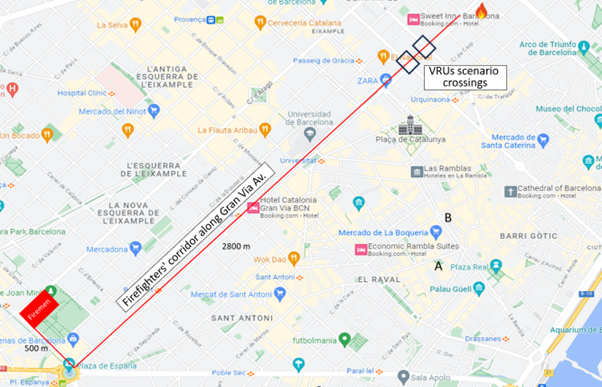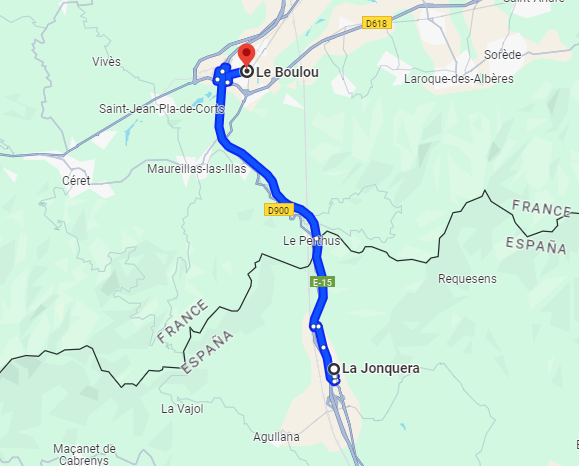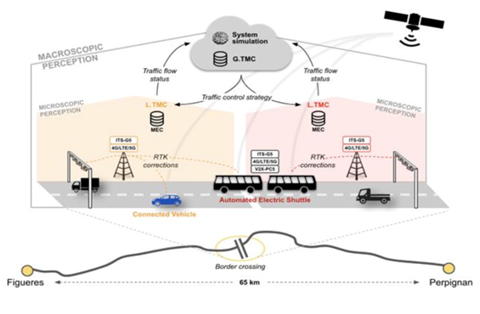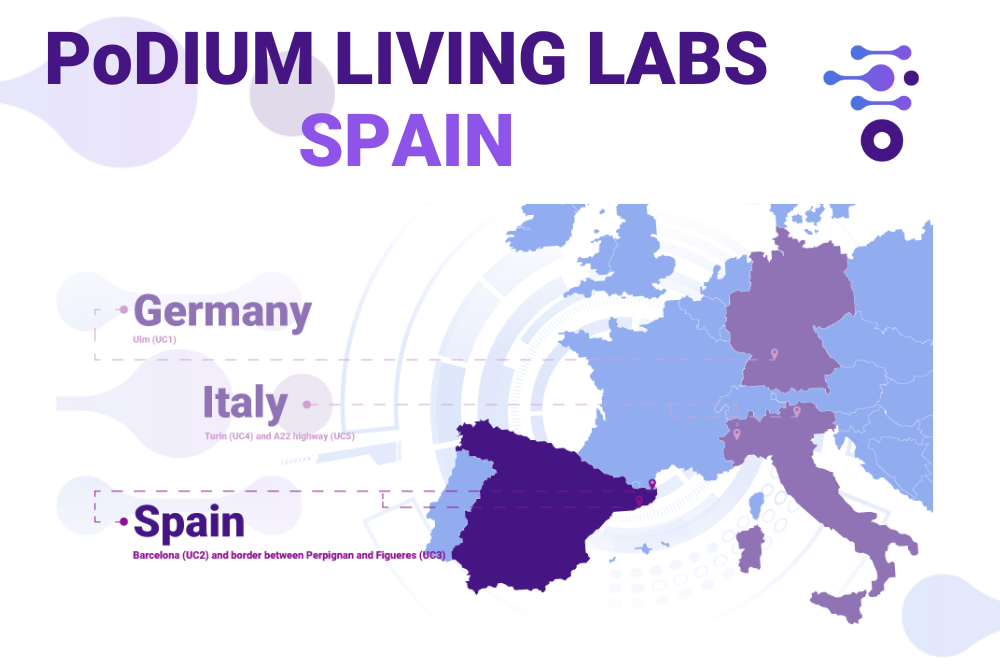In this second article of the ‘Inside PoDIUM’s Living Labs’ series, we delve into the two high-level use cases that will be demonstrated in the Spanish Living Lab of the project. The project partners will work on several scenarios to improve traffic management and safety and reduce incidents, helping realise the PoDIUM vision of advanced Connected, Cooperative and Automated Mobility (CCAM) services in Europe.
Managing high-priority vehicles and protecting vulnerable road users in Barcelona
The use case that will be demonstrated in the city of Barcelona, titled ‘Physical and Digital Infrastructure for a User-Centric, CCAM-enabled Traffic Management in Urban Corridors with High Priority Vehicles and Vulnerable Road Users’, will take place on a 2.5 km stretch along the bustling Gran Via Avenue in the heart of the city. As one of the main avenues in Barcelona, the Gran Via Avenue is an intricate urban zone with heavy traffic, a firefighter corridor, public transport lines, and pedestrian and bike lane crossings, which pose challenges in terms of traffic safety and efficiency that CCAM technologies aim to address.

Three scenarios will be demonstrated in this dynamic urban environment:
- In the first scenario, the Traffic Management Centre (TMC) in Barcelona will communicate with a vehicle from the firefighters’ fleet in emergency state to create a safe route along a specific corridor. The TMC will modify traffic lights to allow the high-priority vehicle to drive through crossings without having to stop. Other Connected and Automated Vehicles (CAVs) will be informed of this traffic plan and the presence of the emergency vehicle through the infrastructure and C-ITS messages.
- In the second scenario, every CAV will relay its position, speed, and route to the infrastructure to optimise traffic management, minimise accidents, and reduce congestion. The Traffic Management System (TMS) will use multi-criteria optimisation algorithms to select the most appropriate strategy to control the road network and provide alternative routes.
- Finally, the third scenario will address vulnerable road user protection at complex intersections where obstacles are hindering CAV sensors. Artificial intelligence cameras installed on the road will detect the presence, position, and trajectory of vulnerable road users, while CAVs send their position and speed to the infrastructure. The infrastructure will then assess the risk of collision and issue a warning through C-ITS messages to both vehicles and vulnerable road users in case of imminent danger.
Using advanced technologies including cloud/edge developments and different types of communication to optimise latency, robustness, and efficiency, the use case in Barcelona will contribute to the most appropriate application of CCAM technologies to improve the efficiency of emergency vehicles, while optimising traffic management and reducing the risk of accidents involving vulnerable road users with the support of the physical and digital infrastructure.
“I think that the most relevant aspect of this use case is the contribution to safer and more efficient mobility in a highly challenging urban environment, leading to a greater supported use of physical and digital infrastructure while testing innovative developments in conjunction with technologies already deployed. The key is to achieve the successful integration of all these elements to advance in the right direction towards a safer implementation of connected and automated mobility.”
Jorge Suárez Luque, ETRA I+D
Cross-border daily commuting and safety incidents mitigation
The second use case in the Spanish Living Lab will take place in the border region between Le Boulou (France) and La Jonquera (Spain), on a section of the E15 highway that connects Barcelona and Perpignan. The Living Lab is located on two contiguous 10 km and 8 km sections of the highway on each side of the border.


The use case demonstrated there, ‘Real-time responsive PDI for CCAM-enabled Traffic Management in the Mediterranean Cross-Border Corridor’, will explore two scenarios:
- The first scenario will evaluate the new functionalities developed as part of the project for an on-demand, sustainable commuting service using an automated shuttle to transport users from a mobility hub on one side of the border to a mobility hub on the other side. The aim is to maximise the use of the shuttle and minimise its presence on the road without passengers onboard or without goods loaded. The shuttle will work on continuous service during peak hours, and on-demand during off-peak hours through a dedicated mobile app. Traffic status will be monitored through data received by the traffic cameras, connected vehicles, and third-party providers, and appropriate traffic management strategies are launched automatically by the TMC.
- The second scenario will follow the point of view of the automated shuttle and demonstrate solutions offered by the new CCAM services to mitigate potential risks, such as an incident caused by another vehicle, be it automated or conventional, or safety-related issues self-reported by the shuttle during its journey. The safe and timely response and mitigation of risky scenarios are key factors here, as well as robustness, low latency and high bandwidth communications taking advance of edge computing, allowing for real-time supervision and the future deployment of fully autonomous shuttles without a security operator.
The scenarios considered in this use case will allow for automated traffic management, leading to safer and more efficient highway traffic. Through early detection and warning of incidents on the highway, congestion and CO2 emissions could be reduced, allowing drivers to adapt their speed to create a safer driving environment.
“This use case faces key challenges for the future of mobility: the enablement of Mobility-as-a-Service (MaaS), and the proactive and automated management of incidents with autonomous vehicles. The Traffic Management Centres (TMCs) of the future will be key in these situations, and the cross-border scenario adds even more complexity to the previous use cases by putting the focus on the interoperability of the systems.”
David Porcuna Sanchez, Autopistas
A collaborative effort between the project partners
Several project partners contribute to the success of the Living Lab demonstrations. In the Barcelona use case, ETRA I+D acts as the use case leader. It will provide the technology for traffic management and will contribute to the advancement of urban traffic management services and the inclusion of vulnerable road users in the road management process. Applus+ IDIADA also plays a key role in this use case by contributing to the integration of all C-ITS developments, which allows for the communication between vehicles and the infrastructure, as well as by providing the connected vehicles for the demonstrations. The MILLA GROUP provides an automated L4 shuttle for the demonstrations, and ISFM, which is owned by MILLA, is in charge of the software developments, including the robotics and autonomous driving systems of the shuttle. Retevisión – Cellnex, as a telecommunications operator, provides the communications infrastructure via 5G and C-V2X, and services for supporting the use case demonstrations. The mobility department of the Barcelona City Council will make available the city for the demonstration, ensuring that all the deployments help and contribute to safer mobility in Barcelona. Finally, the Municipal Institute of Information Technology as a body of Barcelona City Council will take care that both physical and digital infrastructures fit in the ICT local strategy.
The cross-border use case is led by Abertis Autopistas, which will develop the Mobility Hub and Traffic Management Centre for highway operations on safety and traffic flow. Retevisión – Cellnex will provide and set up the communication systems (5G, C-V2X), as well as the On-Board Units and Road-Side Units hardware. Similarly to the Barcelona use case above, MILLA and ISFM will provide the automated shuttle for the on-demand service with tele-supervision. Applus+ IDIADA is in charge of the development of the V2X communications gateway and CV software stack, together with i2CAT and Universitat Politècnica de Catalunya, which will also develop a digital twin and a collision risk alert for vulnerable road users. The mobile app to use the on-demand shuttle service will be provided by ENIDE, together with Tenalach Consulting they will be involved in the development of business models for on-demand passenger and goods transport for the use case.

